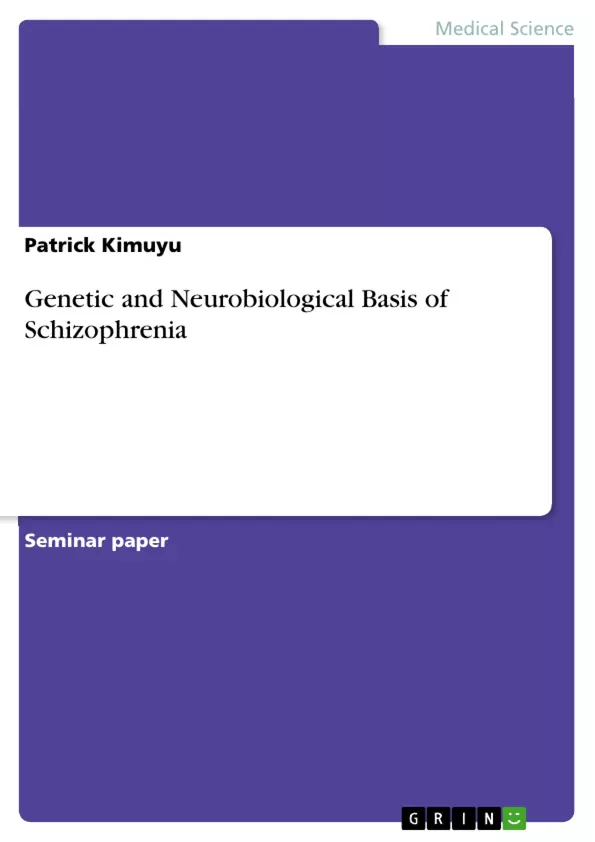Schizophrenia has emerged as one of the most debilitating psychiatric disorders, and it impacts on an individual’s quality of life. Its prevalence is approximately 1.0%, whereas its incidence ranges from 0.16 to 0.42/1000 individuals. Evidence indicates that genetics have an integral role in the onset of schizophrenia. Some of genes involved in the development of schizophrenia include RELN gene, GRM3 gene, COMT gene, and NOS1AP gene. Similarly, neurological dysfunctions including dopamine and glutamate dysfunction have been identified as some of the main factors underlying the pathophysiology of the disorder. Overall, there is evidence that support the biological basis of schizophrenia.
Inhaltsverzeichnis (Table of Contents)
- Abstract
- Introduction
- Genetic Basis of Schizophrenia
- Genetic Loci Associated with Schizophrenia
- Gene Variants and Schizophrenia Risk
- Genetic Changes and Schizophrenia
- Neurobiological Basis of Schizophrenia
- Glutamate Hypothesis
- Dopamine Hypothesis
- Interneuron Dysfunction
Zielsetzung und Themenschwerpunkte (Objectives and Key Themes)
This paper aims to explore the biological basis of schizophrenia, specifically focusing on the genetic and neurological mechanisms involved in its pathophysiology.
- The genetic basis of schizophrenia and the identification of key genes associated with the disorder.
- The role of neurological dysfunctions, including dopamine and glutamate imbalances, in the development of schizophrenia.
- The impact of schizophrenia on the individual's quality of life and societal consequences.
- The epidemiological prevalence and incidence of schizophrenia.
- The exploration of various hypotheses related to the neurobiological basis of schizophrenia.
Zusammenfassung der Kapitel (Chapter Summaries)
- Abstract: This section provides a concise overview of schizophrenia as a debilitating psychiatric disorder, highlighting its prevalence, incidence, and the crucial role of genetics and neurobiological factors in its development.
- Introduction: This chapter introduces schizophrenia as a disorder characterized by hallmark symptoms such as avolition, hallucinations, and delusions. It discusses the epidemiological data regarding its prevalence and the lack of understanding surrounding its etiology and pathophysiology. The chapter highlights the focus of the paper on exploring the genetic and neurological mechanisms underlying schizophrenia.
- Genetic Basis of Schizophrenia: This chapter examines the role of genetics in the onset of schizophrenia. It explores the findings of epidemiological studies that linked schizophrenia to familial inheritance and discusses the identification of key genes involved in the development of the disorder through genome-wide studies. This section also investigates the role of specific gene variants and genetic changes in increasing the risk of schizophrenia.
- Neurobiological Basis of Schizophrenia: This chapter delves into the neurological dysfunctions that contribute to the pathophysiology of schizophrenia. It examines the glutamate hypothesis, the dopamine hypothesis, and the interneuron dysfunction hypothesis, providing evidence for the involvement of these factors in the manifestation of schizophrenia symptoms.
Schlüsselwörter (Keywords)
The key terms and concepts discussed in this paper include schizophrenia, genetics, neurobiology, dopamine, glutamate, interneurons, NMDA receptors, dopamine D2 receptors, gene variants, genetic loci, RELN gene, GRM3 gene, COMT gene, NOS1AP gene, and the impact of schizophrenia on quality of life and society.
- Quote paper
- Patrick Kimuyu (Author), 2018, Genetic and Neurobiological Basis of Schizophrenia, Munich, GRIN Verlag, https://www.grin.com/document/411952



